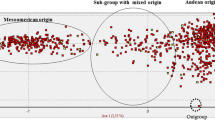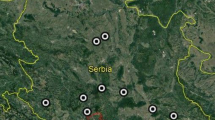Abstract
An investigation was made of the phylogenetic relationships among wild accessions of Lima bean (Phaseolus lunatus) and wild allies of Mesoamerican and Andean origins, using electrophoresis of seed storage proteins and isozymes. Mesoamerican wild species are phylogenetically more distant fromP. lunatus than Andean species, and apparently belong to the tertiary gene pool of Lima bean. The Andean wild species, which are investigated for the first time, reveal a high similarity to the Lima bean, and particularly with its Mesoamerican gene pool. These Andean species probably constitute a secondary gene pool of Lima bean, and are thus of considerable interest in the context of genetic improvement of the crop. Based on these observations, an Andean origin is suggested for the Andean wild species and forP. lunatus. These results point out the importance of collecting and conserving AndeanPhaseolus germplasm.
Similar content being viewed by others
References
Al-Yasiri S. A., Coyne D. P. (1966) Interspecific hybridization in the genusPhaseolus. Crop Sci. 6: 59–60.
Baudoin J.-P. (1988) Genetic resources, domestication and evolution of lima bean,Phaseolus lunatus. In: Gepts P. (ed.) Genetic resources ofPhaseolus beans; their maintenance, domestication, evolution, and utilization. Kluwer Academic Publishers Dordrecht, Holland, pp. 393–407.
Baudoin J.-P. (1991) La culture et l'amélioration de la légumineuse alimentairePhaseolus lunatus L. en zones tropicales. Ede, Pays-Bas: Centre Technique de Coopération Agricole et Rurale (CTA) and Gembloux, Belgique: Faculté des Sciences Agronomiques de Gembloux (FSAGx).
Baudoin J.-P., Katanga K. (1990) Phyletic relationships within the genusPhaseolus on basis of pollen morphology and experimental hybridization. Bean Improvement Cooperative. Annual Report 33: 117–118.
Baudoin J.-P., Katanga K., Maréchal R., Otoul E. (1985) Interspecific hybridizations withPhaseolus lunatus L. and some related wild species. Bean Improvement Cooperative. Annual Report 28: 67–68.
Brown J. W. S., Ma Y., Bliss F. A., Hall T. C. (1981) Genetic variation in the subunits of globulin-1 storage protein of French bean. Theor. Appl. Genet. 59: 83–88.
Burkart A. (1952) Las leguminosas Argentinas silvestres y cultivadas. 2nd edn. Acme Agency, Buenos Aires, Argentina.
Cabral J. B., Crocomo O. J. (1989) Interspecific hybridization ofPhaseolus vulgaris, P. acutifolius andP. lunatus using in vitro technique. Turrialba 39: 243–246.
Carter G. F. (1945) Plant geography and culture history in the American southwest. Viking Fund, New York, USA.
De Candolle A. (1883) Origine des plantes cultivées. Paris, France: Librairie Germer Baillière.
Debouck D. G. (1986a)Phaseolus germplasm collection in Cajamarca and Amazonas, Perú. Rep. No. AGPG/IBPGR: 86/161. — International Board for Plant Genetic Resources (I.B.P.G.R.) Rome.
Debouck D. G. (1986b)Phaseolus germplasm collection in Northwestern Argentina. Rep. No. AGPG/IBPGR: 86/112. International Board for Plant Genetic Resources (I.B.P.G.R.), Rome.
Debouck D. G. (1988) Recolección de germoplasma dePhaseolus en Bolivia. Abril 23 — Mayo 14, 1988. Centro Internacional de Agricultura Tropical (C.I.A.T.), Cali, Colombia.
Debouck D. G. (1989) Recolección de germoplasma dePhaseolus en el norte del Perú. Julio 19 – Agosto 11, 1989. Centro Internacional de Agricultura Tropical (C.I.A.T.), Cali, Colombia.
Debouck D. G. (1990) CollectingPhaseolus germplasm in Ecuador. Centro Internacional de Agricultura Tropical (C.I.A.T.), Cali, Colombia.
Debouck D. G. (1991) Systematics and morphology. In: van Schoonhoven A., Voysest O. (eds.) Common beans: research for crop improvement. C.A.B. International, Wallingford, UK, pp. 55–118.
Debouck D. G., Tohme J. (1988) Recolección de germoplasma dePhaseolus en el Centro-Sur del Perú. Mayo 14 – Junio 1, 1988. Centro Internacional de Agricultura Tropical (C.I.A.T.), Cali, Colombia.
Debouck D. G., Liñan J., J. H., Campanas S., A., de la Cruz Rojas, J. H. (1987) Observations on the domestication ofPhaseolus lunatus L. Pl. Genet. Resources Newslett. 70: 26–32.
Debouck D. G., Maquet A., Posso C. E. (1989) Biochemical evidence for two different gene pools in lima bean,Phaseolus lunatus L. Bean Improvement Cooperative. Annual Report 32: 58–59.
Dejoux C. (1994) Le lac Titicaca. La Recherche 263: 276–284.
Delgado S., A. O. (1985) Systematics of the genusPhaseolus (Leguminosae) in North and Central America. Ph.D. Thesis, University of Texas, Austin.
Federici C. V. T., Waines J. G. (1988) Interspecific hybrid compatibility of selectedPhaseolus vulgaris L. lines withP. acutifolius A. Gray,P. lunatus L., andP. filiformis Bentham. Bean Improvement Cooperative. Annual Report 31: 201–202.
Felsenstein, J. (1993) PHYLIP (Phylogeny Inference Package). Computer program distributed by the author, Department of Genetics, University of Washington, Seattle, USA.
Fofana B., Vekemans X., du Jardin P., Baudoin J.-P. (1997) Genetic diversity in Lima bean (Phaseolus lunatus L.) as revealed by RAPD markers. Euphytica 95: 157–165.
Forero E. (1988) Botanical exploration and phytogeography of Colombia: Past, present and future. Taxon 37: 561–566.
Freyre R., Ríos R., Guzmán L., Debouck D. G., Gepts P. (1996) Ecogeographic distribution ofPhaseolus spp. (Fabaceae) in Bolivia. Econ. Botany 50: 195–215.
Gutiérrez S. A., Gepts P., Debouck D. G. (1995) Evidence for two gene pools of the lima bean,Phaseolus lunatus L., in the Americas. Genet. Resources Crop Evol. 42: 15–28.
Hamann A., Zink D., Nagl W. (1995) Microsatellite fingerprinting in the genusPhaseolus. Genome 38: 507–515.
Harlan J. R., De Wet J. M. J. (1971) Toward a rational classification of cultivated plants. Taxon 20: 509–517.
Harms H. (1921) Einige neuePhaseolus-Arten. Notizbl. Bot. Gart. Berlin-Dahlem 7: 503–508.
Hidalgo R. (1991) C.I.A.T.'s worldPhaseolus collection. In: van Schoonhoven A., Voysest O. (eds.) Common beans: research for crop improvement. C.A.B. International, Wallingford, UK, pp. 163–197.
Honma S., Heeckt O. (1958) Bean interspecific hybrid involvingPhaseolus coccineus ×P. lunatus. Proc. Amer. Soc. Hort. Sci. 72: 360–364.
Hucl P., Scoles G. J. (1985) Interspecific hybridization in the common bean: a review. HortScience 20: 352–357.
Hussain A., Bushuk W., Ramírez H., Roca W. (1988) A practical guide for electrophoretic analysis of isoenzymes and proteins in cassava, field beans and forage legumes. Centro Internacional de Agricultura Tropical (C.I.A.T.), Cali, Colombia.
Jaaska V. (1996) Isoenzyme diversity and phylogenetic affinities among thePhaseolus beans (Fabaceae). Pl. Syst. Evol. 200: 233–252.
Jacob M., Zink D., Nagl W. (1995) Rflps of the rRNA genes in the genusPhaseolus. Genet. Resources Crop Evol. 42: 97–106.
Kami J., Becerra V., Debouck D. G., Gepts P. (1995) Identification of presumed ancestral DNA sequences of phaseolin inPhaseolus vulgaris. Proc. Nat. Acad. Sci. USA 92: 1101–1104.
Kaplan L. (1971)Phaseolus: diffusion and centers of origin. In: Riley C. L., Kelley J. C., Pennington C. W., Rando, R. L. (eds.) Man across the sea. University of Texas Press, Austin, pp. 416–427.
Kaplan L., Kaplan L. N. (1988)Phaseolus in archaeology. In: Gepts P. (ed.) Genetic resources ofPhaseolus beans; their maintenance, domestication, evolution, and utilization. Kluwer Academic Publishers, Dordrecht, Holland, pp. 125–142.
Katanga K. (1989) Création d'hybrides interspécifiques entre le haricot de lima (Phaseolus lunatus L.) et plusieurs espèces sauvages du genrePhaseolus. Possibilités de leur utilisation pour l'amélioration de l'espèce cultivée. Thèse de Doctorat, Faculté des Sciences Agronomiques, Gembloux, Belgique.
Katanga K., Baudoin J.-P. (1990) Analyses méiotiques des hybrides F1 et étude des descendances F2 chez quatre combinaisons interspécifiques avecPhaseolus lunatus L. Bull. Rech. Agron. Gembloux 25: 237–250.
Koenig R., Gepts P. (1989) Allozyme diversity in wildPhaseolus vulgaris: further evidence for two major centers of genetic diversity. Theor. Appl. Genet. 78: 809–817.
Kuboyama T., Shintaku Y., Takeda G. (1991) Hybrid plant ofPhaseolus vulgaris L. andP. lunatus L. obtained by means of embryo rescue and confirmed by restriction endonuclease analysis of rDNA. Euphytica 54: 177–182.
Laemmli I. K. (1970) Cleavage of structural proteins during the assembly of the head of bacteriophage T4. Nature 227: 680–685.
Leonard M. F., Stephens L. C., Summers W. L. (1987) Effect of maternal genotype on development ofPhaseolus vulgaris L. ×P. lunatus L. interspecific hybrid embryos. Euphytica 36: 327–332.
Linnaeus C. (1753) Species Plantarum. Stockholm, Sweden.
Lioi L., Lotti C. (1996) Allozyme variability in cultivated Lima bean (Phaseolus lunatus L.). Bean Improvement Cooperative. Annual Report 39: 249–250.
Lioi L., Esquivel M., Castiñeiras L., Hammer K. (1991) Lima bean (Phaseolus lunatus L.) landraces from Cuba: electrophoretic analysis of seed storage proteins. Biol. Zentralbl. 110: 76–79.
Macbride J. F. (1943) Flora of Peru —Leguminosae. Field Museum of Natural History, Chicago, USA.
Mackie W. W. (1943) Origin, dispersal and variability of the lima bean,Phaseolus lunatus. Hilgardia 15: 1–24.
Manen J. F., Otoul E. (1981) Etudes électrophorétiques et détermination des fractions protéiques principales chez quelques cultivars élites dePhaseolus lunatus L. et dePhaseolus vulgaris L. Bull. Rech. Agron. Gembloux 16: 309–326.
Maquet A. (1995) Étude de la diversité génétique de la légumineuse alimentairePhaseolus lunatus L. par l'analyse de caractères morphophysiologiques et de marqueurs protéiques. Thèse de Doctorat, Faculté Universitaire des Sciences Agronomiques, Gembloux, Belgique.
Maquet A., Baudoin J.-P. (1997) Aperçu de la distribution néotropicale dePhaseolus lunatus. Belg. J. Bot. 130: 93–116.
Maquet A., Wathelet B., Baudoin J.-P. (1994) Étude du réservoir génétique de la légumineuse alimentairePhaseolus lunatus L. par l'analyse électrophorétique d'isozymes. Bull. Rech. Agron. Gembloux 29: 369–381.
Maquet A., Zoro Bi I., Delvaux M., Wathelet B., Baudoin J.-P. (1997) Genetic structure of a Lima bean base collection using allozyme markers. Theor. Appl. Genet. 95: 980–991.
Maréchal R., Mascherpa J.-M., Stainier F. (1978) Étude taxonomique d'un groupe complexe d'espèces des genresPhaseolus etVigna (Papilionaceae) sur la base de données morphologiques et polliniques, traitées par l'analyse informatique. Conservatoire et Jardin Botaniques de Genève, Genève, Suisse.
Masaya P., White J. W. (1991) Adaptation to photoperiod and temperature. In: van Schoonhoven A., Voysest O. (eds.) Common beans: research for crop improvement. C.A.B. International, Wallingford, UK, pp. 445–500.
Murphy R. W., Sites Jr., J. W., Buth D. G., Haufler C. H. (1990) Proteins I: isozyme electrophoresis. In: Hillis D. M., Moritz C. (eds.) Molecular systematics. Sinauer, Sunderland, Massachusetts, pp. 45–126.
Nei M. (1978) Estimation of average heterozygosity and genetic distance from a small number of individuals. Genetics 89: 583–590.
Nienhuis J., Tivang J., Skroch P., Dos Santos B. (1995) Genetic relationships among cultivars and landraces of lima bean (Phaseolus lunatus L.) as measured by RAPD markers. J. Amer. Soc. Hort. Sci. 120: 300–306.
Page R. D. M. (1996) An application to display phylogenetic trees on personnal computers. Computer Applic. Biosci. 12: 357–358.
Piper C. V. (1926) Studies in AmericanPhaseolineae. Contributions U. S. Nat. Herb. 22: 663–701.
Schmit V. (1988) Catálogo de germoplasma de:Phaseolus coccineus L. yPhaseolus polyanthus Green. Centro Internacional de Agricultura Tropical (C.I.A.T.), Cali, Colombia.
Schmit V. (1989) Catálogo de germoplasma de:Phaseolus coccineus L. yPhaseolus polyanthus Green. Anexo. Centro Internacional de Agricultura Tropical (C.I.A.T.), Cali, Colombia.
Smartt J. (1990) Grain legumes: evolution and genetic resources. Cambridge University Press, Cambridge.
Sousa S. M., Delgado S. A. (1993) MexicanLeguminosae phytogeography, endemism, and origins. In: Ramamoorthy T. P., Bye R., Lot A., Fa J. (eds.) Biological diversity of Mexico: Origins and distribution. Oxford University Press, Oxford, pp. 459–511.
Sullivan J. G., Freytag G. (1986) Predicting interspecific compatibilities in beans (Phaseolus) by seed protein electrophoresis. Euphytica 35: 201–209.
Tohme J., Gonzalez D. O., Beebe S., Duque M. C. (1996) AFLP analysis of gene pools of a wild bean core collection. Crop Sci. 36: 1375–1384.
Toro O., Lareo L., Debouck D. G. (1993) Observations on a noteworthy wild lima bean,Phaseolus lunatus L., from Colombia. Bean Improvement Cooperative. Annual Report 36: 53–54.
Van Rossum F., Vekemans X., Meerts P., Gratia E., Lefèbvre C. (1997) Allozyme variation in relation to ecotypic differentiation and population size in marginal populations ofSilene nutans. Heredity 78: 552–560.
Vavilov N. I. (1992) Origin and geography of cultivated plants. Cambridge University Press, Cambridge, UK.
Zoro Bi I., Maquet A., Wathelet B., Baudoin J.-P. (1997) Genetic control of alcohol dehydrogenase, malate dehydrogenase, and phosphoglucomutase isozymes in lima bean (Phaseolus lunatus L.). Pl. Breed. 116: 181–185.
Author information
Authors and Affiliations
Rights and permissions
About this article
Cite this article
Maquet, A., Vekemans, X. & Baudoin, J.P. Phylogenetic study on wild allies of Lima bean,Phaseolus lunatus (Fabaceae), and implications on its origin. Pl Syst Evol 218, 43–54 (1999). https://doi.org/10.1007/BF01087033
Received:
Accepted:
Issue Date:
DOI: https://doi.org/10.1007/BF01087033




